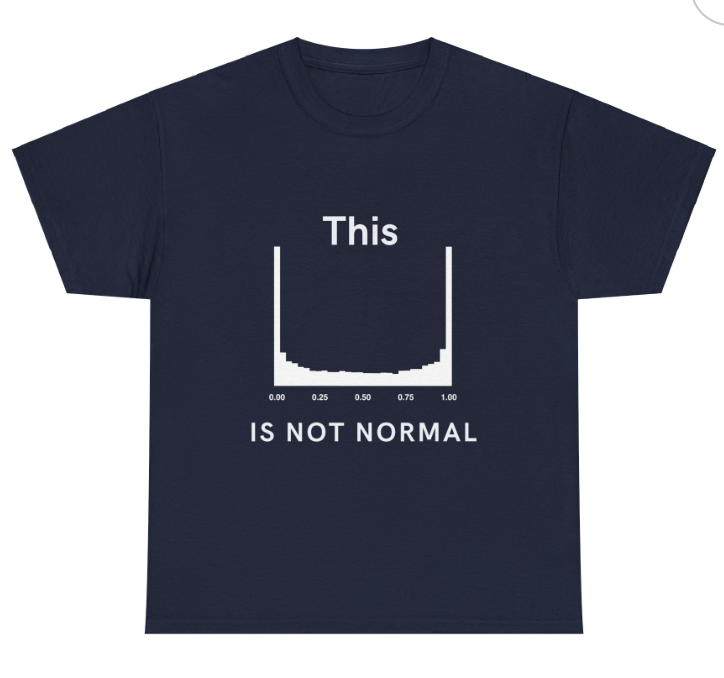This website contains information about the R package ordbetareg and general information about other implementations of the ordered beta regression model in other statistical packages. If you just want to get started with the R package ordbetareg, see the vignette.
About the Model
Proportion data–percentiles, slider scales, visual-analog scales–have long puzzled statisticians because they combine two things: a continuous measure (the proportion) and a discrete measure (the top value of 1 or 100% and the bottom value of 0 or 0%). Conventional statistical models like the oft-used OLS regression implicitly assume these boundaries do not exist; this means an OLS regression can predict to absurd values like 115% of patients being sick or -5% of legislators being elected.
To address this issue, I developed the ordered beta regression model that combines two things: beta regression, which is defined for any bounded continuous scale, and ordered logit, which works for discrete categories. By doing this, you can fit an ordered beta regression for any percentile/proportion for both the middle continuous part and the bounds of the scale. This model can also predict within this scale as well.
I describe the model and how to do this type of modeling in this blog post. For more detail on the inner workings of the model, I refer you to the paper:
Kubinec, Robert. 2023. “Ordered Beta Regression: A Parsimonious, Well-Fitting Model for Continuous Data with Lower and Upper Bounds.” Political Analysis 31(4): 519–36. doi: http://doi.org/10.1017/pan.2022.20.
For an ungated version of the article, see the pre-publication draft on OSF:
Support ordbetareg
If you’ve enjoyed using the package, consider buying some ordbetareg swag! Click the image below to go to the online store (I receive a few dollars from each order).
How to Use the Model
At present, ordered beta regression is available in Stan (Section 3.5), R (Section 3.1), Python (Section 3.2), Stata (Section 3.3), and Julia (Section 3.4). R has the strongest support for the model with multiple implementations, but it is perfectly usable in other statistical frameworks. Below I briefly describe the available packages.
R
Ordered beta regression is currently available in R in two different packages: ordbetareg and glmmTMB. The primary difference between these two packages is estimation method and the number of ordered beta-specific functions. ordbetareg is a package that estimates a Bayesian implementation as described in the paper above by using brms, a powerful R package for Bayesian regression. ordbetareg is maintained by me and you can see the full source code here on Github (and report an issue with the package if you have one). The package includes auxiliary functions like power analysis and plots that are specific to proportion responses—check out the package vignette for more details.
glmmTMB, by contrast, is a general purpose regression package that specializes in mixed multilevel models. It implements a broad array of regression models using maximum likelihood. This means that a model estimated in glmmTMB will almost certainly be faster than ordbetareg (although if you set up ordbetareg to use cmdstanr it can get pretty fast). On the other hand, maximum likelihood estimation has some limitations. Arguably the most important one is that it can be tricky to fit a model that doesn’t have observations at the bounds, i.e. either 0 (0%) or 1 (100%). The Bayesian implementation in ordbetareg has no problem doing this.
That being said, I think glmmTMB is a fine package and believe it works fine for many scholars’ problems. brms, which ordbetareg is based on, offers a lot more features, including native support for multiple imputation, time series modeling and even latent variable/factor analysis modeling, but it does require more setup and the models are generally slower.
For either package, I highly recommend using marginaleffects, and in particular the avg_slopes function, to convert the coefficient estimates in the package to the bounded scale (i.e. between 0 and 1). This function allows you to then interpret your model estimates as the effect of a covariate in terms of percentage change/proportion change in the bounded response/outcome. marginaleffects is available on CRAN and works great with both ordbetareg and glmmTMB.
With both of these packages available, ordered beta regression has very strong support in R. If you don’t have a preference for a particular software package and want to use this model, I would recommend R.
Python
Ordered beta regression is implemented using the scipy package with maximum likelihood estimation. At present, you’ll need to clone (i.e., download) this Github repository to install the package as it is not yet available with pip or conda forge. The package includes plotting functions specific to proportion outcomes and reports coefficient values in the untransformed (logit) scale. marginaleffects support for this package is coming soon.
Stata
There is initial support for Stata as a set of .ado files that can be downloaded and installed in the ado folder in your Stata machine. More details are available on the Github repository. This package supports using the margins command to convert coefficients to the bounded outcome scale, although it does not support all Stata features as of yet. There are plans to make this package available via SSC in the near future.
Julia
Ordered beta regression is available via the SubjectiveScalesModels.jl package, which offers support for a variety of regression models useful in cognitive psychology and other fields with sliders/visual analog scales. The package includes neat visualizations and is maintained by Dominique Makowksi.
Stan
As is evident in the paper, the original model was written in Stan code. While I no longer am maintaining the Stan code, it is available in the paper repository and works great. If you want to incorporate the likelihood or other Stan code into your Stan model, feel free!

